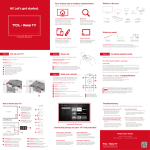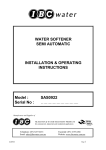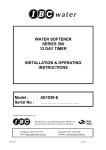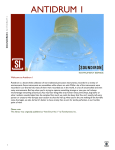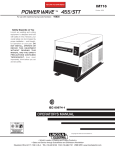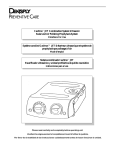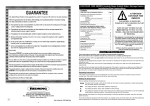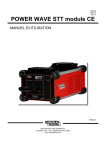Download Clover C12E Troubleshooting guide
Transcript
1 TABLE OF CONTENTS 1. SPECIFICATION & IDENTIFICATION .............................................................................2 2. OPERATION & PARTS FUNCTION OF PARTS....................................................................................3, 4 A. Cooling Operation B. Function of Parts 3. REQUIREMENTS.......................................................................................................4 LOCATION 4. INSTALLATION PROCEDURES ..................................................................................................5 5. STORAGE.......................................................................................................……………………..5 6. CLEANING ..................................................................................................……………………….6 7. TROUBLESHOOTING GUIDE..............................................................................………..…....7, 8 8. DIAGRAM………………………….........................................................………..…….......9 WIRING 9. EXPLODED VIEW & SERVICE PARTS LIST A. C12E..................................................................................................................................10, 11 FOR YOUR SAFETY Please read the following safety precaution before servicing the watercooler. 1) Check if an electric leakage occurs in the appliance. 2) To prevent electric shock, unplug prior to servicing. 3) In case of testing with power on, wear rubber gloves to prevent electric shock. 2 4) When using an instrument or replacing a part for repairing, check it is applied to rated voltage current and capacity. 5) Prevent water from flowing into electric elements in mechanical parts. 6) When carrying or tilting the appliance, remove all the objects on it. 7) If the cooling cycle is out of order, contact nearest authorized service center for maintenance, repair and adjustment. 1. SPECIFICATION & PARTS IDENTIFICATION COLD MODEL C12E (CHILLER) DIMENSION 410W×210D×290H(mm) WEIGHT 12.5kg CONSUMPTION 120W TEMP CONTROL AUTO TANK Stainless Steel CAPACITY 5.0 ℓ/h (10 ) ELECTRICAL 220-240V, 50/60Hz. 110-127V, 50/60Hz. Check the available power supply against the watercooler data plate to assure correct electrical service. 3 2. OPERATION & FUNCTION OF PARTS 4 A. Cooling Operation The vapor refrigerants that compressed to high temperature & high pressure conditions in the compressor, turn into liquid refrigerant of high temperature and high pressure passing through the condenser, and then turn into the liquid refrigerants of low temperature and low pressure conditions by passing through the capillary tubes. The liquid refrigerant of low temperature & low pressure absorbs the surrounding heat while evaporating in the evaporator. Then, it is sucked in the compressor by turning into saturated vapor. B. Function of Parts ① Compressor: Compresses the vapor refrigerant sucked from the evaporator and discharges it to condenser ② Condenser: Changes the compressed vapor refrigerant into the liquid refrigerant by cooling. ③ Drier: Removes moisture and dirt inside pipes ④ Capillary tube: Reduces the pressure of liquid refrigerant and evaporates it in the evaporator under constant pressure. ⑤ Evaporator: Absorbs the surrounding heats while evaporating the liquid refrigerant, cools down water inside of cold water tank. ⑥ Cold water thermostat: Senses the temperature of cold water tank and controls the electric power supply to the compressor automatically in order to keep the constant temperature of cold water. ⑦ Over Load Protector (OLP): Protects the compressor and operates when rising up to abnormal temperature or energizing over current. ⑧ PTC Starter: Starts up the motor of compressor. ⑨ Drain cap: By opening this, you may drain out remaining water in hot water tank when cleaning or not using cooler for a long period of time. 3. LOCATION REQUIREMENTS A. This unit is intended to be installed underneath a conventional kitchen sink, in a cabinet not less than 36”" (914mm) wide (inside dimension). Chiller may be installed in any location in the cabinet base as long as there is a minimum of 5”" (127mm) between unit and cabinet walls. In order to have necessary air exchange for the unit, a free air opening of at least 60 square inches (387 cm²) should be provided in the kitchen counter. The opening should be located as close to the unit as possible and can be made in the ‘ toe space of the counter’ or ‘ above the toe space’ B. Make sure installation ground is flat and even. - Unbalanced placement may cause excessive noise and trembling of the cooler. C. Coolers are for indoor use only. Keep away from direct sunlight and excessive moisture. D. Avoid harmful gas or excessive heat. 5 4. INSTALLATION PROCEDURES A. Connect the 1/4”OD tubing between water inlet of chiller and the supply water hose with pressure rating suitable for use with the application. The tubing must be acceptable for use with potable water. B. Using the 1/4”OD tubing included with the (gooseneck) faucet, connect on water outlet of chiller. -Flush water in lines before installing gooseneck faucet. -Acceptable supply water pressure is 15~100 PSI (100~700kPa) CAUTION: TO PREVENT PROPERTY DAMAGE DUE TO WATER LEAKAGE, SEEK INSPECTION BY PLUMBERS TO SEE THE WATER PRESSURE IS LESS THAN 100PSI (690KPA) BEFORE YOU CONNECT THE SUPPLY WATER HOSE. C. Slowly open supply water valve. By opening faucet lever, let water flows for about one minute. Check all the connections. -Purge off all air from all water lines by opening faucet lever. Steady stream assures all air is ventilated. D. Prior to drinking, flush water through chiller for at least 5 minutes. E. Check the available power supply against the chiller data plate to assure correct electrical service. F. Plug in chiller and the chiller will be ready to serve you cold water in 30 minute after installation CAUTION: FAILURE TO ABIDE BY ABOVE PROCEDURE CAN CAUSE PHYSICAL DAMAGE ON THE COOLER. 5. STORAGE A. Unplug power cord. B. Open faucet until water is room temperature. C. Close the source water valve. D. Disconnect the water pipe from the product. E. Place a bucket beneath the drain pipe. Open the drain cover and cap. Then, drain the remaining water. F. When storing, ensure it stands on its erect position on the flat and even ground. (Do not lay the product on its sides down or upside down.) G. When not use for a long period of time, conduct product cleaning before you put in storage. CAUTION: FAILURE TO ABIDE BY ABOVE PROCEDURE MAY INCUR PHYSICAL DAMAGE ON THE COOLER. 7. TROUBLESHOOTING GUIDE 6 TROUBLE POSSIBLE CAUSE REMEDY REFRIGERATION SYSTEM A. Compressor does not run. B. Water is adequately chilled, but cooler runs excessively or continuously. C. The cooler compressor runs continuously, but I do not have cold water. D. The cooler excessively and the cold water is not cold enough. E. The cooler has a No electric power to outlet. Turn on electric power outlet. The thermostat is misadjusted or Adjust or replace the thermostat, as defective. necessary. The wires leading to the thermostat are Check the internal wiring. defective or are not connected. Make repairs as necessary. Check the line voltage. It must be at The line voltage is low. least 90% of minimum voltage. The compressor over-load Replace the defective over-load Protector (OLP) is defective. protector. The starting relay (PTC) is defective. Replace the starting relay. Replace the compressor. The compressor is defective. Return cooler to authorized service center or factory for repair. Poor ventilation. Minimum side & rear clearance 4" Clean the condenser or relocate the The condenser is dirty or restricted. unit to prevent restricting the condenser. The thermostat is defective. (the Replace or adjust the thermostat as contacts are shorted or the control is necessary. not adjusted properly) It is normal for the cooler to run The ambient temperature is high. continuously at high ambient temperatures. There has been a substantial loss in If refrigerant leak is suspected, return the sealed system's charge of cooler to authorized service center or refrigerant. factory for repair. The compressor is defective. Same as above. The condenser is dirty or restricted. Clean the condenser and relocate the cooler to prevent restricting the condenser. The cold water thermostat is set high and or the cooler is in a high ambient environment. Usage of the cold water system is greater than the cooler capacity. The temperature of supply water is too high The refrigeration system is overcharged or undercharged. There is a partial restriction in the refrigeration system. If wattage readings are normal, the 7 Check the thermostat setting. Adjust the setting as necessary. Inform the customer of the cold water system's maximum capacity. Wait for a moment until cold water is made Return cooler to authorized service center or factory for repair. Replace the thermostat. thermostat may be defective. The thermostat is improperly set for the is cooling, but does not prevailing environmental conditions and run long enough to cooler usage. The compressor motor is defective, cool water to the causing the cooler to cycle on the overload required level. protector. F. A. The cold water The cold water thermostat is so much low, flows slowly or not at causing ice to build up in the reservoir, all. blocking water flow. short running cycle. It Replace the thermostat. Adjust the thermostat. Replace the compressor. Return cooler to authorized service center or factory for repair. Defrost cooler. Adjust the temperature control. NOISE The cooler must be leveled. Place the cooler on even surface. The cooler is not level. A. There is excessive noise coming from the cooler, but it is otherwise operating normally. A section of the tubing inside the cooler is touching other parts of cooler, causing noise to be generated due to vibration. Check the connection of the fixed screws. The compressor's operation is noisy because of inherent conditions. Adjust position of the tubing to make sure it is not in contact with any other parts. Completely connect the fixed screws. Advise the customer of the cooler's normal operating sounds. WATER LEAKAGE A. Leakage through inside of appliance Return chiller to authorized service center or factory for repair. The cold water tank leaks. OTHERS A. Odd taste and smell in Water Mineral concentration of supplied water is somewhat high. No use for a long time. When using a water pressure regulator. B. Strong water flow Supplied water pressure is set up too high originally. 8 This product does not include filters. Change the existing filter or use a proper one. Continue to let the water flow until it runs clear. Adjust a regulator according to it’ manual or contact a qualified engineer. Install a regulator that can control the pressure or contact a qualified engineer. 9 10










